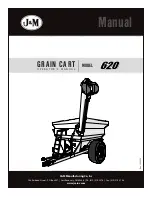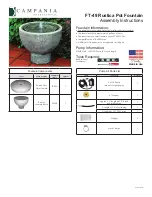
REV. 11-16-18 Page 21
Round Flat Disc Fire Pits
REQUIREMENTS
1. Only non-combustible materials should come in direct contact with any part of the fire pit. Underneath area should be non-
combustible or a flat level combustible surface according to the clearances specified in this manual.
2.
Refer to the NFPA54 (National Fuel Gas Code) for proper pipe sizing. See gas pipe sizing chart on page 7.
3. Determine the size of the round fire pit you are preparing to install (Refer to page 4).
4.
You must provide a round opening out to place the flat disc onto the non-combustible enclosure. Do not exceed the
maximum opening from Table 1, dimension B located on page 4.
5. Follow the local code requirements for the gas type being used. This fire pit should be installed in accordance with
local codes and ordinances or in the absence of local codes, with the latest National Fuel Gas Code, ANSI Z223.1
NFPA54 or CSA B149.1, Natural and Propane Installation Code in Canada.
6. Fire pits create high temperatures, it is very important to have any combustibles at a safe distance. Refer to page 4.
7. Normal operation of the fire pit is with a battery pack that is supplied with your system (Fig 18). The battery box has
12-feet of black sleeved wire that is to be passed through the junction box provided. This wire should not be cut or
spliced and the junction box can be placed in the facing of the vertical finish of the fire pit, if you place the wire under
ground you should install those wires into an approved protective conduit/sleeve material.
8. Fire pit should never be left unattended while in operation. It should always be a safe distance from all trees and
combustible landscape materials.
10. Construction of the finished fire pit should be stable and solid. From the bottom of the control box that houses the
gas valve and module, it should be a according to specifications on Table #1.
NOTE
:
Proper drainage is critical to
ensure that water does not damage gas valve and components.
Never install fire pit below grade.
11.
CAUTION: The fire pit enclosure MUST have a minimum ventilation of 18 square inches on each side to keep the
inside of the finished enclosure dry.
We recommend installation of a VENT-KIT-6x12. See accessory section.
12. The insulation square pad provided with the fire pit is to be placed foil up toward the bottom of pan on top of the
valve box.
13. Never fill the cavity under and around the valve box with any material, this is a provided air space necessary for
ventilation.
14. These products are designed for outdoor use only. Not approved for any indoor use.
15. This fire pit is designed to have decorative rock, lava rock/media covering the burner, so the burner is not visible. Optional
concrete logs can be added to consumers taste. Decorative rock is not provided. When purchasing decorative rock use
minimum of 1 to 2-inch diameter rock as a base to fill the burner pan.
DO NOT COVER THE IGNITION HOOD WITH
ANY ROCK OR MEDIA.
16. Gas lines and fittings must be installed in to the non-combustible structure. All gas connections must be leak tested
before installation of the fire pit. Soapy water leak detection is required before regular use of the fire pit.
17. Do not use material that will absorb moisture over time and will not release this moisture quickly. Moisture can boil in this
material and can rapidly break apart and cause damage or personal injury.
18. Never leave any other combustible material on top of the fire pit. This could cause unsafe operation of this system
and damage to the component that will not be covered under the warranty.
INSTALLATION OF FIRE PIT INTO AN APPROVED ENCLOSURE
NOTE
: Gas valve, flexible gas lines and TFS components are
supplied. Gas shut-off is not supplied.
Battery pack can be installed within the 12-foot wire length. If
exposed to the elements a weather proof box is recommended.
Fig. 20
Typical installation.
VALVE
BOX
SHUT-OFF
BATTERY PACK
SECTION C THERMOCOUPLE FLAME SENSE (TFS) INST
ALLA
TION
Flat disc pans are typically uses with landscape blocks. The illustrations below show examples of possible installations.
NOTE:
Methods of supporting the center of the disc underneath
or supporting an oversized opening are shown on page 9 in
Figs. 6 & 7.
f i r e - p a r t s . c o m
















































